Flowers have long held significant symbolism in human culture, conveying messages and emotions with their colors, scents, and arrangements. Among the myriad meanings attributed to different blooms, one of the most poignant is the symbolism of remembrance. In times of loss, grief, or commemoration, flowers play a crucial role in expressing sentiments of love, honor, and tribute. Understanding the significance behind the flowers chosen for remembrance can deepen our appreciation for the rituals of mourning and celebration of life. In this article, we delve into the rich symbolism of flowers associated with remembrance, exploring their historical context, cultural significance, and enduring relevance.
The Historical Roots of Floral Remembrance
Floral tributes as expressions of remembrance trace back through millennia of human history, spanning various cultures and civilizations. Ancient civilizations, including the Egyptians, Greeks, and Romans, incorporated flowers into funeral rites and memorial practices. The ancient Greeks, for instance, adorned graves with wreaths made from laurel leaves and flowers as symbols of honor and eternal memory.
Lest We Forget: The Symbolism of Poppies
Among the most iconic symbols of remembrance is the poppy flower. The association of poppies with commemorating fallen soldiers originated from the famous poem “In Flanders Fields” by Lieutenant Colonel John McCrae during World War I. The blood-red poppies that grew amid the desolate battlefields of Flanders became a powerful symbol of sacrifice and remembrance. Today, poppies are worn on Remembrance Day in many countries to honor those who have died in conflicts.
Aromatic Tribute: Lavender and Rosemary
Lavender and rosemary are two fragrant herbs with deep-rooted associations with remembrance. Lavender, with its soothing scent and delicate purple blooms, has long been used in funeral rituals to evoke feelings of calm and tranquility. In addition to its aromatic qualities, lavender symbolizes devotion and remembrance, making it a fitting choice for honoring loved ones.
Rosemary, with its woody fragrance and needle-like leaves, carries symbolic significance in various cultures. In ancient folklore, rosemary was believed to enhance memory and fidelity, making it a poignant symbol of remembrance and loyalty. It is often incorporated into funeral bouquets and wreaths as a tribute to the departed.
Eternal Beauty: White Roses and Lilies
White roses and lilies are classic choices for expressing sympathy and remembrance. White roses, with their pristine petals and timeless elegance, symbolize purity, innocence, and reverence. They are often used in funeral arrangements to convey heartfelt condolences and eternal love for the departed.
Lilies, with their graceful blooms and symbolic association with purity and renewal, hold special significance in remembrance ceremonies. The white lily, in particular, symbolizes the restored innocence of the soul and the hope of life everlasting. Its delicate fragrance and striking appearance make it a cherished flower for honoring the memory of loved ones.
The Symbolism of Forget-Me-Nots
Forget-me-nots are small, delicate flowers with a poignant symbolism that aligns perfectly with the concept of remembrance. Legend has it that the name “forget-me-not” originated from a medieval German tale in which a knight, upon drowning, threw a bouquet of these blue blooms to his lover, urging her not to forget him. Since then, forget-me-nots have been associated with enduring love, loyalty, and remembrance. They are often included in sympathy bouquets and memorial gardens as a tender reminder of cherished memories.
Cultural Variations in Floral Remembrance
The symbolism of flowers associated with remembrance can vary significantly across different cultures and traditions. For example, in Asian cultures such as Japan and China, chrysanthemums hold a prominent place in funeral rites and ceremonies. In Japan, chrysanthemums symbolize grief and lamentation, while in China, they represent longevity and immortality. Similarly, marigolds are used in Mexican Dia de los Muertos celebrations to honor deceased loved ones, symbolizing the beauty and fragility of life.
Conclusion
In times of loss and remembrance, flowers serve as powerful symbols of love, tribute, and reverence. From the blood-red poppies of Flanders Fields to the fragrant lavender of ancient funeral rites, each bloom carries its own unique symbolism and cultural significance. By understanding the language of flowers and their associations with remembrance, we can honor the memories of those we have lost and find solace in the beauty of nature’s enduring tribute. As we weave together the threads of history, tradition, and personal sentiment, let us take comfort in the timeless symbolism of flowers as symbols of remembrance and eternal love.


